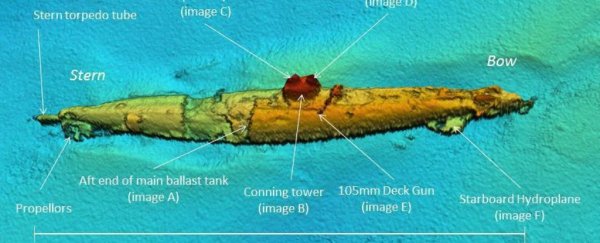Scottish engineers have discovered an iconic World War I submarine on the bottom of the Irish Sea, and it's revived an old internet mystery.
The German U-boat has been identified as a submarine that was sunk back in 1918 by British forces. But the internet has some other ideas about what went down, saying a sea monster could have been involved.
The submarine wreckage was found by engineers who were surveying the Irish Sea for new underwater power cables.
Based on photos of the wreck and the sub's design, researchers from Bournemouth University in the UK were able to accurately date it, and say it looks like a UB III-class sub that saw heavy use by the Germans in WWI.
A standout feature was the 105-mm deck gun – a gun that was only typical on UB III-class subs for about six months during the war – which suggests that the vessel sank some time in April 1918.
Based on British war records, the researchers say the sub looks be one of the two UB III-class subs that sunk in that area during that month of the war: UB-82, which was sunk by British patrol boats on 17 April 1918; or UB-85, which was sunk by the HMS Coreopsis on 30 April 1918.
The possibility of the latter is what the internet has latched onto, because if it happens to be UB-85, it could reignite a conspiracy theory that the sub was actually damaged by a sea monster prior to the HMS Coreopsis sinking it for good.
The rumours, which are of course all unsubstantiated, first started back in 2005 after several message boards started claiming that the captain of the U-boat – who survived the sub's sinking along with the rest of the crew – had stated that a sea monster had forced the boat to surface, making them an easy target for the British.
"The story goes that he claimed the U-boat had surfaced during the night to recharge her batteries and give the sailors a chance to have a smoke," recounts debunking site the Iron Skeptic.
"While surfaced, an enormous sea serpent appeared and climbed onto the side of the ship. The men, startled, began shooting at it with their side arms, which apparently infuriated the beast and made it bite down on or grab hold of the forward gun."
The legend states that in the end, the monster managed to break the deck of the sub, making it impossible for them to dive again, leaving them vulnerable to the British, who seized the opportunity and sank the vessel.
No one is sure where this story actually came from, or if the captain ever really told it in this way, though Bournemouth researcher Innes McCartney told Tom Metcalfe at Live Science that no one had reported such an incident to British authorities after their capture. No surprises there.
But McCartney says tall tales like these were common in the early days of submarine expeditions.
"[The sea monster myth] falls into a longer trend going back at least to the 1930s of these outlandish sea tales being appended to First World War German submarines," McCartney told Live Science.
"I don't know why it is, but the first U-boat war just attracts these stories – you get haunted submarines, like UB-65 which [supposedly] had a dead crewmember who haunted the boat, and then UB-28 – another sea monster is supposed to have attacked that one."
The problem is, it's hard to truly discredit these internet rumours without evidence. And for now, scientists aren't able to differentiate whether this submarine was UB-82 or UB-85. (We probably won't be able to say for certain either way until the other wreck is discovered.)
"It would be nice for the other one to show up, which it will do - these things are being found so quickly these days," McCartney told Live Science.
"And then you've got the two, and it may be possible simply by looking at the damage compared to the combat reports from both instances and the positional analysis to be fairly certain."
With further study, maritime archaeologists will hopefully be able to figure out which U-boat they just found, and maybe even put the mystery of the sea monster to bed once and for all.
